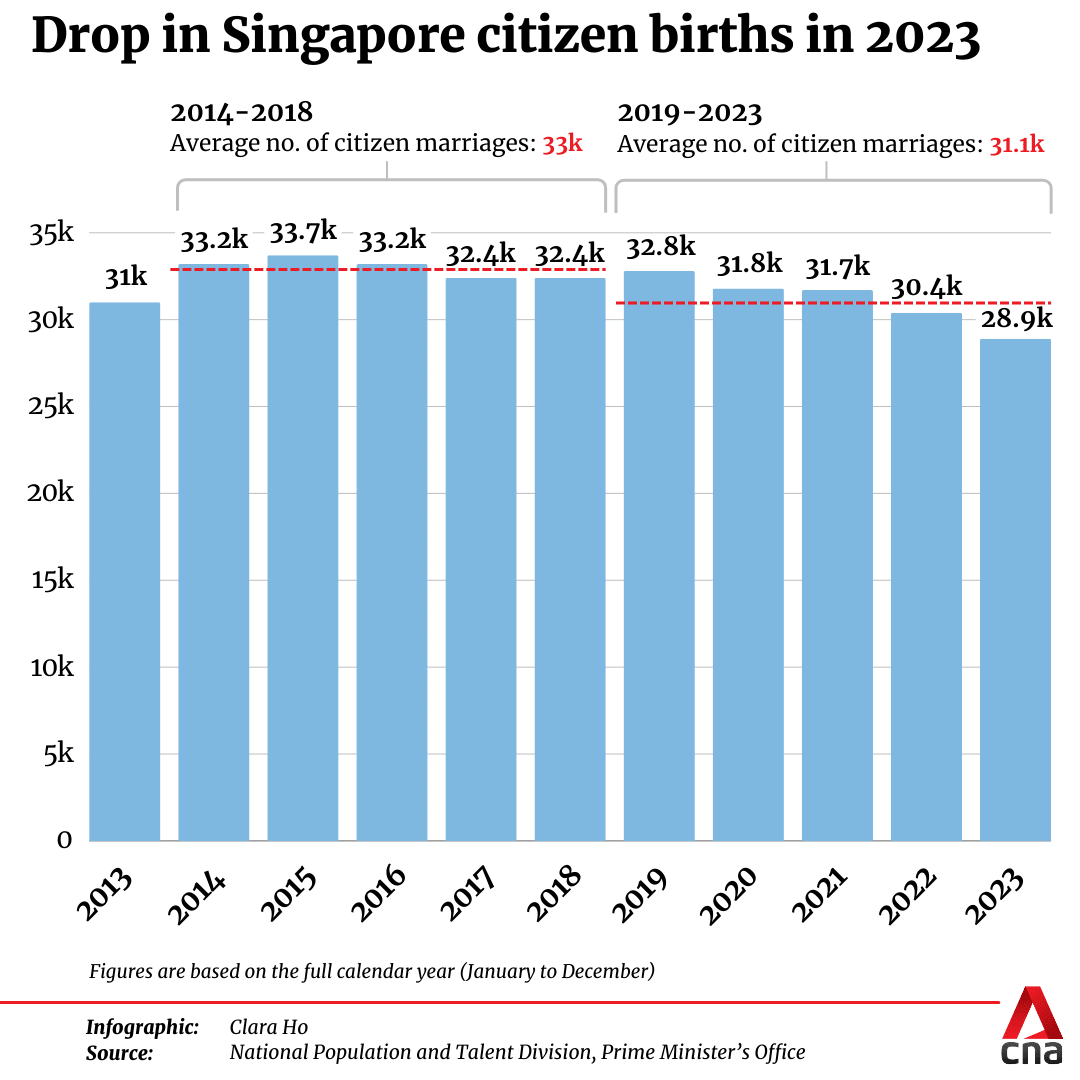Fewer marriages and Singaporean births in 2023
The number of citizen marriages last year fell by 1.7 per cent from the record high of 24,767 the year before, but remained higher than pre-pandemic levels.


This audio is generated by an AI tool.
SINGAPORE: There were fewer citizen marriages as well as Singaporean births last year, according to the annual Population in Brief report that was released on Tuesday (Sep 24).
In 2023, there were 24,355 citizen marriages, a 1.7 per cent decrease from the record high of 24,767 citizen marriages seen the year before.
However, this was still higher than pre-pandemic levels, according to the report published by the National Population and Talent Division of the Prime Minister’s Office (PMO) and its partner agencies.
The annual average number of citizen marriages between 2019 and 2023 (22,800) was lower than the average recorded between 2014 and 2018 (24,000).

Brides and grooms are also getting older. The median age at first marriage for citizen grooms and brides was 30.7 and 29 years in 2023, up from 30.1 and 27.8 years respectively in 2013.
Slightly over a third (36 per cent) of citizen marriages last year were transnational, similar to pre-pandemic levels of 35 to 39 per cent (from 2013 to 2019).
About one in six citizen marriages last year were inter-ethnic, a proportion that has remained largely stable in the last decade.
Among the citizen population aged 25 to 49 years, there was a higher proportion of singles across almost all age groups last year compared to 2013. This is apart from those aged between 35 and 39 as well as males aged between 40 and 44, which saw a decrease in the proportion of singles.

FALLING BIRTHS, AGEING POPULATION
Citizen births fell by 5.1 per cent to 28,877 last year compared to 2022 (30,429).
Last year, Singapore’s resident total fertility rate (TFR) dropped below 1.0 for the first time, at 0.97.
By race, the TFR for the Chinese population was 0.81. It was 0.95 for the Indian population and 1.65 for the Malay population.
While the TFR has generally been declining over the past few decades, the report said this may have been exacerbated by the COVID-19 pandemic, which resulted in economic uncertainty and disrupted marriage and parenthood plans for some Singaporean couples.
The annual average number of births in the past five years (31,100) was also lower than in the preceding five years (33,000).
The median age of citizen mothers at first birth was 31.4 years in 2023, up from 30.2 years in 2013.

The report added that the proportion of elderly citizens is rising, and at a faster pace than the last decade, as large cohorts of “baby boomers” reach 65 years old.
The median age of the citizen population as of June this year is now 43.4 years old, up from 43 last year. This has increased steadily over the last 10 years from 40.4 years in June 2014.
Currently, 60.4 per cent of citizens are aged between 20 and 64, down from 64.8 per cent in 2014. Nearly one-fifth (19.9 per cent) of citizens are aged 65 and above, up from 12.4 per cent a decade ago. By 2030, around one in four citizens (24.1 per cent) will be aged 65 and above.
The number of citizens aged 80 and above also increased by about 65 per cent, from 85,000 in 2014 to 142,000 this year.
IMMIGRATION
The report said the pace of immigration continues to be “measured and stable”. Last year, 23,472 people were granted citizenship and 34,491 were granted permanent residency (PR).
About 5.7 per cent of the new Singapore citizens, or 1,332 of them, were children born overseas to Singaporean parents.
The average number of new citizenships and permanent residencies granted per year over the last five years (22,400 citizenships and 32,600 permanent residencies) was slightly higher than over the preceding five years (21,600 citizenships and 31,100 permanent residencies).
According to the report, the exact number granted each year depends on several factors, such as the number and quality of applications received.
















